Ancient Egypt for Kids
As one of the greatest civilizations the world has ever seen, the Ancient Egyptians are responsible for many of the ways we live today. Some of these include their inventions in medicine, music, the calendar, and farming. The Egyptian Empire lasted from 3,150 B.C. to 30 B.C. and saw many different pharaohs during the three kingdoms called the Old Kingdom, Middle and New Kingdom.
Ancient Egypt History Timeline
- 3,500 B.C.: The first hieroglyphic symbols are used by craftsmen
- 2,500 B.C.: The Great Pyramid at Giza and The Great Sphinx are built.
- 1,550 B.C. – 332 B.C.: The New Kingdom Pharaohs are buried in the Valley of the Kings.
- 1,351 B.C.: Akhenaten, “Heretic King” starts a religious revolution within Egypt.
- 1,325 B.C.:King Tut (son of Akhenaten) is buried in the Valley of the Kings.
- 30 A.D.: Egypt becomes part of the Roman Empire.
Ancient Egypt’s Greatest Pharaohs
- Cleopatra VII – Although Cleopatra was Greek, she was also the last pharaoh of Egypt. She made alliances with the Romans to maintain her power.
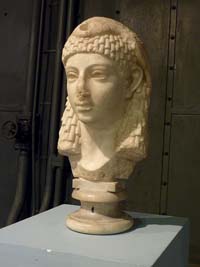
Click here to learn more about Queen Cleopatra (for Kids) - Ramses II – Third pharaoh of the 19th Dynasty, Ramses II is often called Ramses the Great. He built more monuments and statues than any other Egyptian king. He was regarded as one of the most powerful, if not the most powerful, pharaohs of the ancient Egyptian Empire.
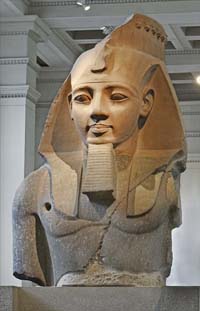
Click here to learn more about Ramses II - Tutankhamun – The son of “Heretic King” Akhenaten, King Tut is famous today solely because of his tomb. It was found intact in 1922 and filled with treasure. He is also well-known because he was a boy of just nine years old when he took power.
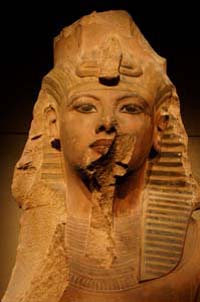
Click here to learn more about King Tut - Amenhotep III – A great pharaoh because during his 39 years of rule Egypt was at peace. It was also prosperous and he was able to expand cities and build many temples. He was the ninth pharaoh of the 18th Dynasty.

Click here to learn more about Amenhotep III
There were a lot more pharaohs in ancient Egypt, who reigned from 3100 BC until 30 BC, more than 3000 years! They were thought to be descendants of the gods.
Click here to learn more about The Ancient Egyptian Pharaohs (for Kids)
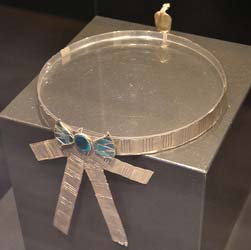
© Jan - 17th Dynasty Diadem
Ancient Egypt’s Greatest Structures
The greatest of all the structures in ancient Egypt are the pyramids. The very first pyramids were called step pyramids, and weren’t smooth on the sides, but rather had “steps.” An example of this type is the First Pyramid of Djoser.
Some of the most famous construction of ancient Egypt are located at Giza:
- The Great Pyramid of Giza stands 480 feet tall. It was the tallest man-made structure in the world until the construction of the Lincoln Cathedral in the UK in 1311 A.D. It is the only remaining Wonder of the Ancient World.
Click here to learn more about The Great Pyramid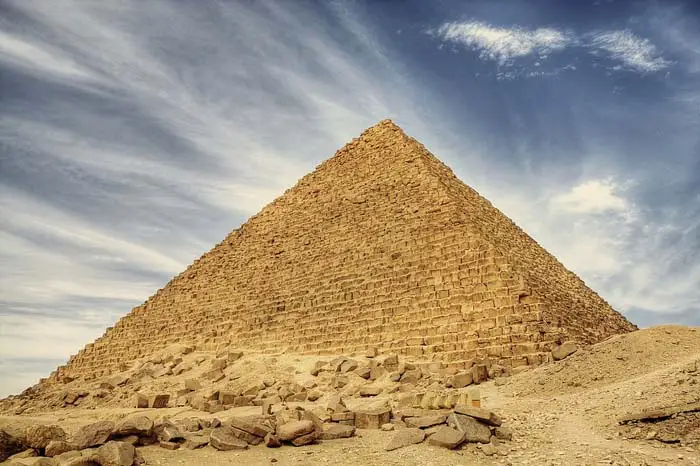
© Never House - The Great Pyramid of Giza
- The Great Sphinx of Giza was carved around 4,500 years ago. It stands 241 feet long, 66 feet high and 20 feet wide. The face on the sphinx was made to resemble Pharaoh Khafra.
Click here to learn more about The Great Sphinx
© Jack Versloot - The Great Sphinx at Giza
Pyramids were built as tombs to house the dead pharaohs. They were stocked with treasures and items they would need in the afterlife such as food, amulets, scarabs, masks and sacrificial objects.
Click here to learn more about The Pyramids of Ancient Egypt
Ancient Egypt’s Most Important Gods
- Ra the Sun God. As the creator of all forms of life and the absolute ruler of all the other gods, Ra had a pretty major role in the god pantheon. He was depicted with a hawk head, headdress and sun disc. At one point, he combined with Amun to create an even more powerful god called Amun-Ra.
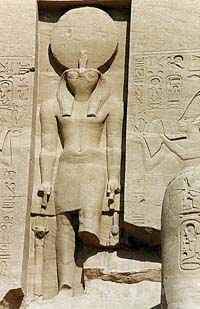
- Osiris. The husband of Isis and father to Horus. Osiris ruled the underworld and was god of the dead.

- Isis. A true mother goddess. She protected people in need and empowered women with knowledge.

- Horus. The son of brother and sister, Osiris and Isis, Horus ruled the sky. The living pharaoh was thought to be the embodiment of Horus.
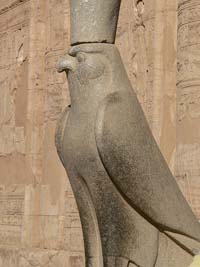
Click here to learn more about The Ancient Egyptian Gods
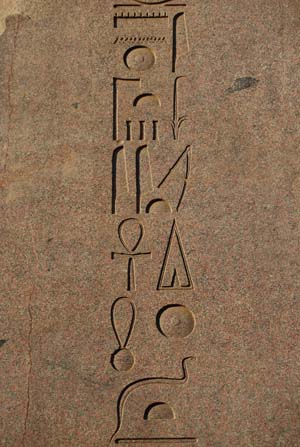
©Aleksandar Cocek - Hieroglyphs at Karnak
River Nile
The Nile played a key part in the development of Ancient Egypt. It provided direct means of transportation across the country, often carrying the materials many constructions were made of. Not only did it become an important trade route, but its recurrent, predictable floods transformed the dry lands into fertile soil. The thriving crops and the abundance of fish in the water supported life in the otherwise barren sands of the African deserts.
Click here to learn more about The Nile River (for Kids)
Hieroglyphs
The ancient Egyptian civilization lasted for thousands of years. Culturally and religiously it changed very little, but from it came incredible inventions and insights that we still use today.
One of the most famous symbols of ancient Egypt is the hieroglyphic writing.
Egyptians developed three types of writing, which were used for papyrus documents and engraved on walls.
People had to follow specific training in order to learn how to write and were named scribes.
Click here to learn more about Egyptian hieroglyphics
